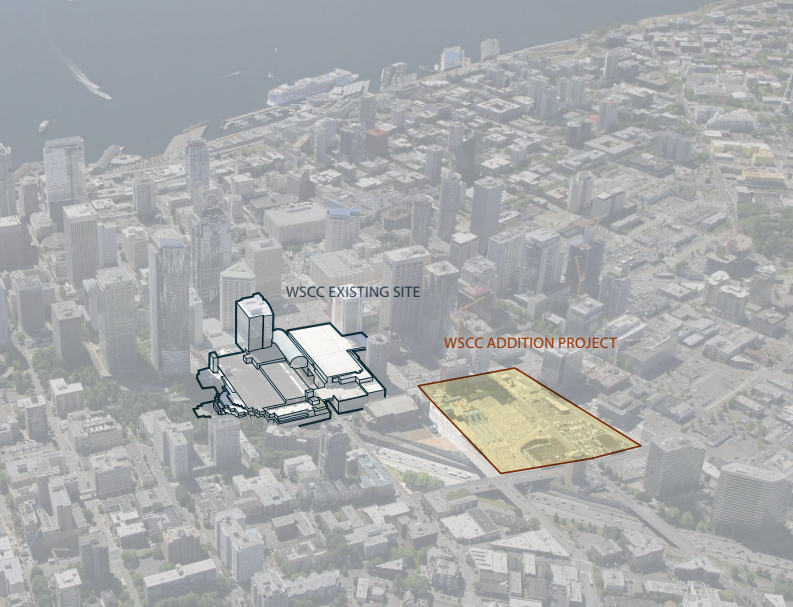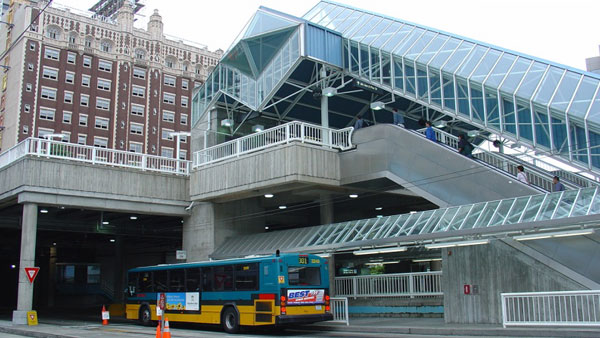King County Executive Dow Constantine recently introduced legislation to the Metropolitan King County Council to approve the sale of Convention Place Station (CPS) to the Washington State Convention Center (WSCC) to facilitate a planned $1.6 billion convention center expansion. The press release from King County touted how the sale will improve Metro service and will benefit taxpayers, transit riders and workers. While the WSCC has very effectively spread its message that the expansion will be good for the region, this sale proposal brings up some unfortunate realities: this expansion will not be good for workers, it will not be good for transit riders, and it will definitely not be good for taxpayers.
While Convention Place Station will eventually close as Link light rail expands (the recent University Link extension bypassed it), the WSCC’s timing for its expansion rushes the planned closure of CPS ahead by several years, and pushes tunnel buses onto surface streets well before light rail will be extended to help alleviate the pain. This is entirely within King County’s control. In negotiating this sale, Executive Constantine (who is typically very supportive of transit) could have required CPS operation until light rail expansion was complete, but WSCC is only required to maintain operation “as long as possible,” meaning it will be shut down in 2018. There is no time pressure (like a voter or supreme court mandate) for the WSCC to expand, and the region’s travel and tourism industry is thriving without it. The $161 million sale price might help Metro’s budget in the short-term, but CPS’s location and direct access to I-5 express lanes are assets with far-reaching, system-wide benefits that are not easily replaced.
Lower income workers are often hardest hit by inefficiencies in public transit. The WSCC has claimed that this project will create 2,300 ongoing jobs at the WSCC and related travel service industries. Many of these service industry jobs are typically low wage jobs, and even with Seattle’s boost in minimum wage, workers in these jobs typically cannot afford market rent anywhere near the WSCC’s campus. Workers will likely face long commutes, and thanks to the WSCC’s negative impact on the regional transit system, their commutes will likely be even longer. The WSCC has offered $5 million for affordable housing as part of a required public benefits package in addition to the $5 million required by this sale proposal, but that total of $10 million is less than 20% of what Capitol Hill Housing deemed reasonable to offset the WSCC’s impact.
The creation of these ongoing jobs is also dependent on the WSCC attracting new out of town visitors. As detailed in an article in The Urbanist last May, attendance at the WSCC has not met any of the expectations set prior to its last major expansion in 2001, and the share of out of town visitors compared to local visitors has been falling. Occasional large events like PAX or ComicCon give the illusion that the WSCC is bursting at the seams, but aside from these occasional events, the WSCC is doing less with more. Nationwide, there is a glut of available convention space, creating a highly competitive environment for convention centers across the country. Unfortunately, the WSCC’s attempt to build its way out of this problem only makes the problem worse.

The WSCC also claims that this project will generate 6,000 construction jobs. Unfortunately, this would be more of a curse than a blessing. As Seattle tops the nation in the number of construction cranes hovering overhead, the current local labor shortage in the construction industry is driving up costs for the WSCC project and for every other project in King County. These jobs would be extremely valuable if the local construction economy were slumping, but by timing this enormous project for the most expensive point in Seattle’s current construction boom, the WSCC is inflating construction prices region-wide, making new housing less affordable, and likely making the inevitable downturn more severe.
The Washington State Convention Center and its expansion project are funded by the lodging tax of 2.8% in King County, and a 7% in Seattle for hotels with more than 60 rooms. In 2015, this came to a total of $73 million in tax revenue for the WSCC. When these lodging taxes were created by the state legislature in the 1980’s, it was argued that travel-related taxes like lodging and car rental taxes (which include car2go and other carsharing services) are only paid by out-of-town visitors. However, these are sales taxes that don’t discriminate by home zipcode. For example, many companies headquartered in Seattle pay the lodging tax whenever out of town employees come in overnight for meetings or training. This represents a significant tax obligation that conveniently stays out of advertised prices, and often gets overlooked in the list of line items in a hotel bill, but in the end affects visitors and locals alike.
At recent public meetings, Matt Griffin, a developer on the project, has indicated that the WSCC is free from oversight from any local or state government, and he is mostly correct on this point. The WSCC’s re-organization as a public facilities district (PFD) in 2010 means it is its own government (rather than the original public nonprofit formed in 1982 by the state legislature), and most oversight from the state legislature was removed. Special taxing districts are common (school districts and the Port of Seattle, for example), but they typically have some form of electoral accountability to the public (school boards and the port commission, for example), especially when they take on multi-billion dollar construction projects. The WSCC’s district, however, has only the most anemic form of accountability through its board of long-serving appointees made by the governor, county executive, and mayor of Seattle. Over half of the WSCC’s board has served for over a decade, and turnover is rare. Board Chairman Frank Finneran has served on the board since 1988, when Seattle and King County faced much different challenges than they do today. The board structure may have made sense for the public nonprofit organization, but minimizes public input into the public facilities district.
Above all, taxes are about priorities, and there is a limit to how much can be extracted from taxpayers, both visitors and locals. When Seattle Public Schools face a $74 million budget shortfall and has to consider laying off teachers, remember that the WSCC increased the budget for this tax-funded project by $200 million last June, without any scramble for funds. When there is a property tax levy on the ballot for $55 million to help ease the homelessness crisis, remember that much more money gets funneled without question to the WSCC every year. When a truck overturns on I-5 causing horrendous traffic delays for drivers and transit riders alike, remember that the Washington State Convention Center actively worked to undermine our very fragile transportation systems. Voters have not approved this massive expansion. Attendance statistics have not shown that an expansion will bring more visitors. King County government needs to act in the interest of its residents, not in the interest of an unaccountable special taxing district.
Contact your County Councilmember and tell them to vote “no” on this sale. It is a bad deal for King County, and an especially bad deal for Seattle.
City Tells Convention Center: Addition Public Benefits Are Too Small
Washington State Convention Center Expansion Is Not Inevitable



